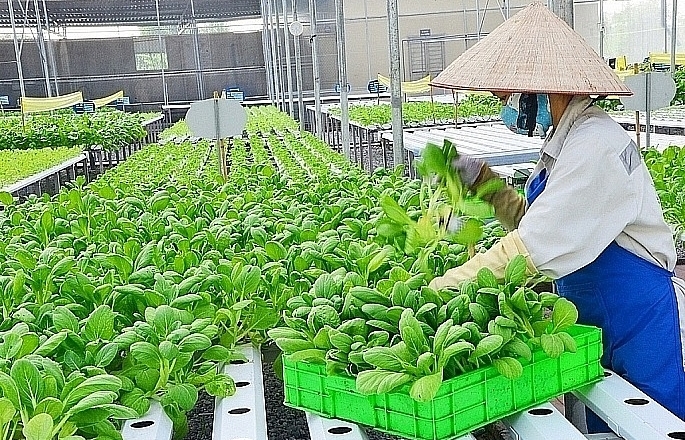VCCI Chairman: Enterprises should become investors with orientations in vocational training
 |
| Mr Vũ Tiến Lộc |
On the sidelines of the Employer Conference in 2018 cooperating with enterprises and schools in training and recruitment, Mr Vu Tien Loc, Chairman of the Vietnam Chamber of Commerce and Industry (VCCI), had a talk with the press around the issue of enterprises involved in labor training.
Please tell us, the role of enterprises in the vocational education institutions in the training of labor?
With the increasing demand of the economy, improving the quality of human resources and labor’s workmanship in enterprises is very important. In order to improve the quality of labor in the labor market, the role of training institutions and enterprises are both important.
Enterprises need to become investors and have education orientation, provide the content of vocational training programs and create institutions for students to practice. At the same time, enterprises can play a role in certifying the qualification of trainees and evaluating the quality of trainees. Enterprises also are places providing the jobs for institutions of vocational education. Thus, the enterprises play the role in all stages of training.
Improving the quality of labor is not only the responsibility of schools and the State but also the responsibility of enterprises. Particularly I think the training period in vocational schools should be shortened, more practical and associated with the enterprise’s practical requirements. Training should be associated with the needs of business, training period at the enterprise and the school should be harmonized so that after graduation students can immediately access to work. At the same time, apprenticeship will also be a lifelong job of the worker. So the combination between school and business is not only in the class but also in the relationship, cooperation with each other during the work of employees in the enterprise.
Now many businesses still stand outside the training of the vocational education institutions, sir?
It is necessary to implement the policies of the Party and State in promoting socialization of professional education. The State builds the legal framework, incentive policies, even invests with private institutions to build training facilities. When the State calls for financial as well as intellectual investment of all people in vocational education, it can form a strong vocational education.
I think it is necessary to increase the awareness of state agencies, schools and enterprises about the role of each factor in vocational training development. The PPP formula is very effective in promoting vocational education, especially in the early stages of the socialization of vocational education.
How should the labor standards in CPTPP relate to vocational training and vocational training be changed?
Meeting the labor standards is a very important requirement of free trade agreements, which also determines whether we can penetrate the world's markets.
Labor standards here not only refer to the technique of the profession but also the quality of the product. In particular, labor standards in these agreements are primarily linked to sustainable development, social responsibility.
Meeting the labor requirements in the integration period we not only enhance the quality of human resources, but also ensure the full implementation of labor standards as well as compliance with social conditions and responsibilities in general.
The Party's policies and the law of the State clearly state the responsibilities of the business sector and the private sector in improving the quality of labor. Now it’s necessary to change the attitudes and perceptions of state agencies and public training institutions, so that the parties find that strengthening cooperation with the private and public sectors and promoting socialization will be a solution to promote vocational training in the coming time.
Thus, the State needs to withdraw from some public services in vocational training that businesses, citizens and business associations can do. For example, organizing vocational training in a number of specialized fields, state agencies do not need to join, but can let professional associations and institutions implement; organizing examinations for testing and granting vocational training certificates, letting business associations cooperate with vocational training establishments; creating conditions for business associations to participate in building training orientation and training program content.
 | Business boom after reforms: VCCI Chairman The Government hopes to attract 135000 new firms in 2018 |
As a result, state agencies are phasing out the technical aspects of vocational training to facilitate the participation of the private sector in this field. Then the State has only played a role in guiding and promulgating the provisions of law and the incentive mechanism for vocational training to become the cause of the entire population.
Related News

Ministry of Finance stands by enterprises and citizens
15:30 | 13/12/2024 Finance

Why seafood exports to some Middle Eastern Countries are stalled
14:47 | 20/11/2024 Import-Export

Businesses need support from vietnamese representative offices abroad
14:48 | 20/11/2024 Headlines

Transparency evates the standing of listed companies
09:47 | 21/11/2024 Finance
Latest News

Nghệ An Province anticipates record FDI amidst economic upswing
15:49 | 26/12/2024 Import-Export

Green farming development needs supportive policies to attract investors
15:46 | 26/12/2024 Import-Export

Vietnamese enterprises adapt to green logistics trend
15:43 | 26/12/2024 Import-Export

Paving the way for Vietnamese agricultural products in China
11:08 | 26/12/2024 Import-Export
More News

VN seafood export surpass 2024 goal of $10 billion
14:59 | 25/12/2024 Import-Export

Exporters urged to actively prepare for trade defence investigation risks when exporting to the UK
14:57 | 25/12/2024 Import-Export

Electronic imports exceed $100 billion
14:55 | 25/12/2024 Import-Export

Forestry exports set a record of $17.3 billion
14:49 | 25/12/2024 Import-Export

Hanoi: Maximum support for affiliating production and sustainable consumption of agricultural products
09:43 | 25/12/2024 Import-Export

Việt Nam boosts supporting industries with development programmes
13:56 | 24/12/2024 Import-Export

VN's wood industry sees chances and challenges from US new trade policies
13:54 | 24/12/2024 Import-Export

Vietnam's fruit, vegetable exports reach new milestone, topping 7 billion USD
13:49 | 24/12/2024 Import-Export

Aquatic exports hit 10 billion USD
13:45 | 24/12/2024 Import-Export
Your care

Nghệ An Province anticipates record FDI amidst economic upswing
15:49 | 26/12/2024 Import-Export

Green farming development needs supportive policies to attract investors
15:46 | 26/12/2024 Import-Export

Vietnamese enterprises adapt to green logistics trend
15:43 | 26/12/2024 Import-Export

Paving the way for Vietnamese agricultural products in China
11:08 | 26/12/2024 Import-Export

VN seafood export surpass 2024 goal of $10 billion
14:59 | 25/12/2024 Import-Export





